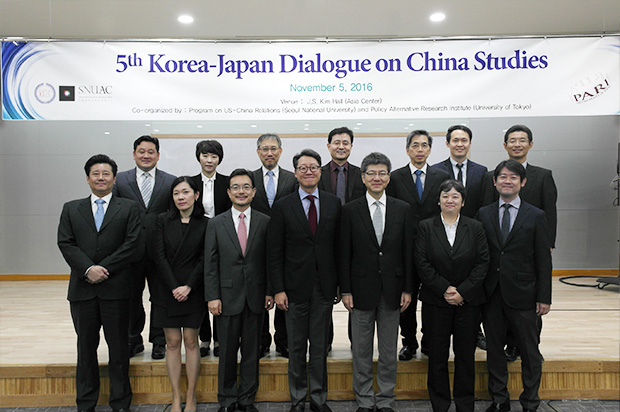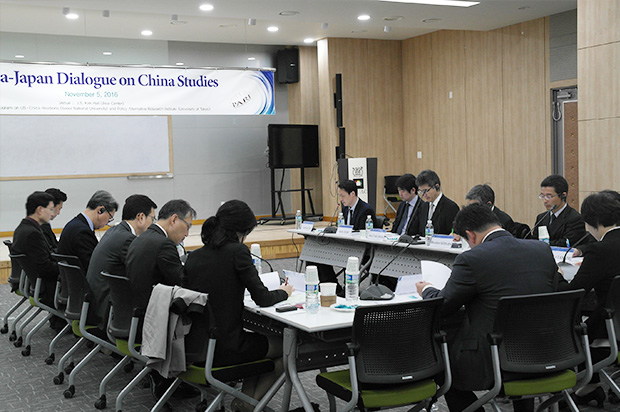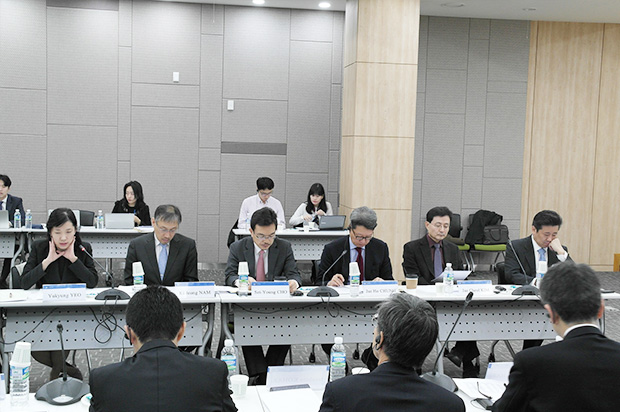5th Korea-Japan Dialogue on East Asian Security 2016
| Date: | Saturday, November 5 2016 |
|---|---|
| Venue: | Seminar Room, Seoul National University |
| Subject: | 5th Korea-Japan Dialogue on East Asian Security 2016 |
| Co-organized by: |
Program on US-China Relations, Seoul National University Security Studies Unit, Policy Alternatives Research Institute, the University of Tokyo |

Saturday, November 5, 2016 – Full-day Workshop
Welcome Remarks and Opening Remarks 09:30-09:45
Jae Ho CHUNG (Seoul National University) & Akio TAKAHARA (University of Tokyo)
Session 1 09:45-11:45 on Assessing China’s domestic situations
Moderator: Jae Ho CHUNG (Seoul National University)
Presenters: Jaehwan LIM (Aoyama Gakuin University)
Yukyung YEO (Kyunghee University)
Lunch Break 11:45-13:00
Session 2 13:00-15:00 on US-China Relations and Northeast Asia
Moderator: Akio TAKAHARA (University of Tokyo)
Presenters: Jae-Cheol KIM (Catholic University)
Masafumi IIDA (National Institute of Defense Studies)
Coffee Break 15:00-15:20
Session 3 15:20-18:00 on Assessing Korea-China and Japan China Relations
Moderator: Seiyoung CHO (Dongseo University)
Presenter: Hankwon KIM (Korea National Diplomatic Academy)
Shino WATANABE (Sophia University)
Dinner 18:30
Report on the 5th Korea-Japan Dialogue on East Asian Security 2016
The 5th Korea-Japan Dialogue on East Asian Security 2016 was held on November 5, 2016, at Seoul National University, where research results were presented, and opinions were exchanged actively, concerning the following three areas: (1) China’s changing domestic situations, (2) U.S-China relations in Northeast Asia and (3) China-Korea and Japan-China relations.
In Session I held in the morning (9:45-11:45), papers were presented, and discussion was conducted, about China’s military reform and economic policy in relation to the country’s domestic situations. The paper on the country’s military reform pointed out that the reform’s focus is on the transfer of authority from the central control body to “Theater Commands,” that the reform aims to strengthen the country’s “joint operations capabilities” by integrating the command and control of different military branches—namely, army, navy, air force and rocket force, and that such reform has been enabled by the institutionalization and law-based control of the military that has been promoted since before Xi Jinping Administration, indicating more continuity than disconnection. In response to the presentation, questions and answers were exchanged, covering an extensive range of topics, such as: Xi Jinping’s personal political influence on the military, the strength of the central control of the military, the impact of the military reform on the military’s internal information sharing, the roles of General Political Department, the reform’s relations to the country’s military doctrine, the influence of the army-centered personnel policy for combat zones on reform and military efficiency, the reform’s relations with the anti-corruption campaign, and the influence of China’s domestic socio-economic situations.

The paper on China’s economic policy indicated that the economic reform currently being implemented in China, in which Xi Jingping and his aides take the initiative, prioritizes a structural reform over growth and emphasizes private investment. It also pointed out many limits that the economic reform faces including the issue of government-owned companies. The presentation also provided perspectives that there is a difference in policy between Li Keqiang’s group emphasizing growth and Xi Jinping’s group prioritizing the structural reform and that Xi Jingping’s power consolidation is not causing a change in China’s collective leadership system. In response to the presentation, questions and answers were exchanged concerning the relations between the anti-corruption campaign and the economic reform, details of the difference between Xi Jingping’s group and Li Keqiang’s group, and the relations of the economic reform to the country’s One Belt, One Road initiative as well as to Asian Infrastructure Investment Bank.
In Session II held in the afternoon (13:00-15:00), a discussion was conducted about U.S.-China relation, pointing out China’s aggressive foreign policy including the exercise of power as well as the lack of U.S.’ effective responses—i.e., the insufficiency of resources allocated by the U.S. for dealing with China’s expansion and the lack of its explicitly indicated intension to cope with it as among causes of uncertainty in East and Southeast Asian regions. On the other hand, another view expressed in the discussion stressed the U.S.’ confrontational stance against China, highlighting the U.S.’ initiatives such as the implementation of the Freedom of Navigation Operation and the enhanced military cooperation with allies and friends. An outlook was further indicated, expecting the U.S.-China relations to become further confrontational given that both the U.S. and China are pressuring medium-sized and small countries to cooperate with the respective countries. Then a variety of topics were discussed as part of questions and answers exchanged, including the roles of medium-sized and small countries in the structure of confrontation between the U.S. and China, causes of the changes in China’s diplomatic policy, Japan’s responses, and the comparison of U.S.’ and China’s military capabilities. Particularly, with respect to the point concerning and reasons behind the insufficiency of resources allocated by the U.S. to cope with China, various aspects were discussed, such as the gaps in responses among the White House, Department of Defense and Department of State and the necessity for the U.S. and China to cooperate in their environmental and economic issues.
In Session III, the last session (15:20-18:00), papers were presented concerning the current status and future prospects of China-Korea and Japan-China relations. First, with respect to China-Korea relations, focusing on the latest issues of North Korea’s nuclear weapons and the deployment of the Terminal High Altitude Area Defense (THAAD) missile system, a perspective was presented that China-Korea relations entered their structural cooling period. The paper pointed out both China’s and Korea’s wishful thinking as a cause of the worsening relations between China and Korea, where Korea had hoped that China would abandon North Korea and allow Korea to lead the integration of Korean Peninsula while, on the other hand, China had expected Korea to take a neutral position between the U.S. and China, both countries having excessive expectations from each other. The wishful nature of such expectations was reveled, the paper argued, by North Korean’ crisis and the THAAD issue--Korea could not accept China’s negative stance toward the countermeasures against North Korea while China could not tolerate the deployment of the THAAD system that would affect its national security. The paper pointed out the difficulty of solving the present issue of worsening China-Korea relations that is rooted in structural problems involving national security and sovereignty issues. Among the questions and answers exchanged, such issues were discussed as whether Park Geun Hye’s actively pursuing Korea’s close relationship with China had caused China to have excessive expectations, what are the alternatives to the THHAD system proposed by the group opposing it, and how China views North Korea’s nuclear weapons. It was also argued that the cooling relations between China and Korea helped narrow the differences between Korea’s ruling and opposition parties and allow them to discuss the country’s national security policy vis-à-vis China on a common ground.

With respect to China-Japan relations, an analysis of current status and prospects based on opinion polls were presented. Polls conducted in Japan and China indicated similar results that negative impressions about the other country were shared in respective countries and that such negative impressions were worsened by the issue concerning their respective sovereignty, i.e., the territorial issue. The paper, based on the results, pointed out the difficulty in foreseeing improved relations between Japan and China. Furthermore, it called attentions to a drastic decrease in Japan’s investment into China and a shift among Japanese companies entering China from manufacturing companies with long-term investment horizons to companies in other sectors that are attracted to Chinese market and seeking to recover their profits in short terms. The questions and answers discussed such issues as the recognition and information gaps between Japan and China, Japan’s response to the Senkaku Islands dispute, the difference in awareness about the possibility of armed conflict between Japan and China, and the current status of the mechanism of communications between Japan and China.
